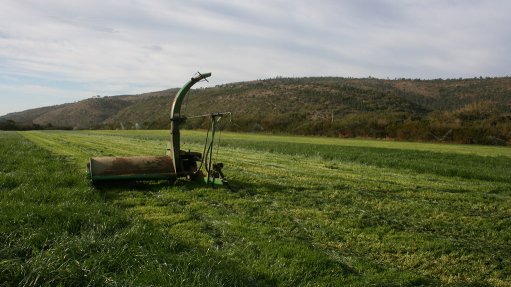
RYEGRASS PASTURE PRODUCTIONThe WRC is investigating irrigated pastures to determine the water use and irrigation requirements of the most common farming practices, including those pertaining to kikuyu/ryegrass, legume/ryegrass mixtures and lucerne
To increase water availability and land productivity, which will cater for the increasing human population, a new project by the Water Research Commission (WRC) will record information about the irrigation management of ryegrass/kikuyu pasture under different pasture management conditions.
Since initiating its five-year study worth R2.75-million in April 2012, the WRC has introduced irrigation guidelines for ryegrass and has been developing calendars for the major pasture-growing areas of South Africa, which have been published as WRC reports.
The WRC has published report TT520/12, which deals with water use and nitrogen application for irrigation management of yearly ryegrass and kikuyu pasture production and report TT521/12 dealing with irrigation guidelines for yearly ryegrass pasture.
The WRC mentions that irrigated agriculture faces strong competition for a substantial share of water, as the water use for industrial, domestic, municipal and other activities are rapidly increasing.
The study has also led to the development of a simple irrigation-scheduling model that is being parameterised and currently tested. This model is available for use by far- mers for their specific farming conditions, explains the WRC.
Returns generated from animal production enterprises make pastures one of the highest-value crops produced under irrigation in South Africa. It is estimated that the total area used for irrigated pasture production is about 16% of the total area under irrigation. Natural veld alone cannot fulfil this need for animal production, which must be supplemented with irrigated and fertilised planted pas- tures. To achieve this, farmers use fertilisers and water intensively, which leads to a higher cost of production and a greater risk of environmental pollution, notes the WRC.
“The most common irrigated pastures are ryegrass, kikuyu and lucerne. Irrigated ryegrass and dryland kikuyu, with supplemental irrigation, are the primary sources of roughage in the pasture-based dairy industry and are mostly grown in the relatively higher rainfall areas,” highlights WRC executive manager for water utilisation in agriculture Dr Gerhard Backeberg.
He says investigations on irrigated pas-tures are being conducted in controlled environ-ments at representative research stations and commercial farms to determine the water use and irrigation requirements of the most common farming practices, including those pertaining to kikuyu/ryegrass, legume/ryegrass mixtures and lucerne.
As part of the WRC project, which is scheduled to end in March 2016, the practice of growing temperate legume with tropical grass or temperate grass mixture and the most commonly practised grazing mixture of kikuyu/ryegrass are being researched, under the leadership of the University of Pretoria’s Department of Plant Production and Soil Science.
“Lucerne is regarded as the most important pasture legume produced in the drier parts of South Africa for its high-quality roughage. This roughage is extensively used in many animal production systems, including feedlots, dairy systems, the animal feed industry and the wildlife industry,” explains WRC project leader Dr Wayne Truter.
He points out that the need, therefore, exists to study more efficient ways of increasing yield and possibly improving the quality of lucerne using less water. Another option could also include imposing stress during different growth stages or using rainfall strategically to improve yield and quality during a period of water scarcity.
“Therefore, once completed, the WRC study will provide more information on the basic understanding of water use and the effects of water stress on lucerne production as a prerequisite for the development of water management strategies,” he explains.
At the completion of the research project, databases of the irrigation requirements for kikuyu/ryegrass and clover/ryegrass mixtures and pure lucerne under different pasture management practices will be developed. The validity and practicality of irrigation tools developed will finally be assessed in conjunction with pasture production stakeholders, notes the WRC.